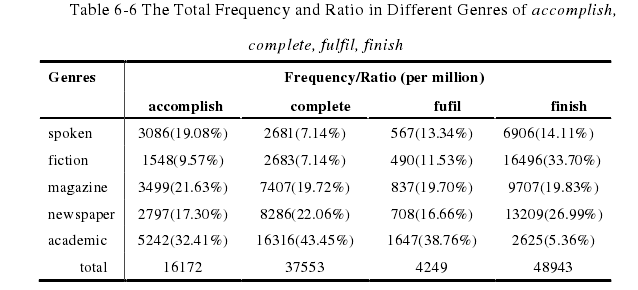联系方式
more本类最新英语论文
- 2024-04-30中国文化形象的多模态隐喻建..
- 2024-04-26基于语料库的男女化妆品广告..
- 2024-04-24宏事件视角下动趋式“v来”..
- 2024-04-23语用等效视域下元话语英译探..
- 2024-04-19生命性和语言水平对宾语关系..
- 2024-04-14新历史主义视角下《奥斯卡·..
- 2024-04-12顺从·反叛·独立——罗洛·..
- 2024-04-01戈尔丁《蝇王》的空间异化探..
- 2024-03-29狂欢化与莎士比亚的《皆大欢..
- 2024-03-25斯宾塞《仙后》(i—iii卷)..
more热门文章
- 2011-02-25英语语言学动名词属性研究:..
- 2010-02-03美式英语与英式英语的区别
- 2010-02-09cultural difference betwe..
- 2010-02-26the relationship between ..
- 2009-04-06浅谈身势语-a brief discus..
- 2010-08-29study english idioms by w..
- 2010-02-03美国文化特征中俚语的研究分..
- 2010-02-11英式美式英语比较分析
- 2010-03-02on the origins of english..
- 2010-03-06the development and socia..
more留学论文写作指导
- 2024-03-31卡森•麦卡勒斯小说中..
- 2024-03-28美国黑人女性心理创伤思考—..
- 2024-03-27乔治·艾略特《织工马南》中..
- 2024-03-21超越凝视:论《看不见的人》..
- 2024-03-19《哈克贝利•费恩历险..
- 2024-03-13心灵救赎之旅——从凯利的三..
- 2024-02-22文学地理学视角下的《印度之..
- 2023-05-03英、汉名词短语之形容词修饰..
- 2023-02-07目的论视域下5g—the futur..
- 2022-07-04二语英语和三语日语学习者的..
英汉学习词典中英语易混淆习语的选录和辨析 [2]
论文作者:www.51lunwen.org论文属性:硕士毕业论文 thesis登出时间:2017-04-13编辑:lgg点击率:3449
论文字数:36214论文编号:org201704081917116426语种:英语 English地区:中国价格:$ 66
摘要:本文是英语语言学论文,本文采用基于语料库的分析,探讨在现实生活中容易混淆的成语的频率来确定是否有必要区分他们。利用当代美国英语语料库对被调查的习语进行词频统计。可口也用于查找单词经常发生混淆的成语。
..........
2.2 Confusable Idioms
There are few studies on confusable idioms, but there are several studies onsynonymous idioms. Two words “Confusable” and “synonymous” should be clearlydistinguished from each other. In order to do this, further research is needed to see thedifferences between confusable words and synonymous words by reviewing previous research findings before the idioms are explored. In fact, the two words “Confusable”and “synonymous” have overlapping relations, rather than parallel relationships.Professor Zhang Bo (2005) proposes that synonyms, which are treated withoutdistinction previously, can be broadly classified into confusable words and synonyms.She points out that confusable words refer to words whose semantic relationships aredistant or without synonymous relationships, but the second language learners oftenmisuse. Synonyms refer to words having the similar semantic meanings.
...........
CHAPTER THREE CONFUSABLE IDIOMS AND THEIR CLASSIFICATION......13
3.1 Definition of Confusable Idioms.........13
3.2 Sources of Confusion........13
3.3 Classification of Confusable Idioms............. 14
3.4 Summary........22
CHAPTER FOUR CONFUSABLE IDIOMS IN LEARNER’S DICTIONARIESAND THEIR ACQUISITION.............23
4.1 Idioms in Existing Learner’s Dictionaries....23
4.1.1 Dictionaries of Idioms......23
4.1.2 Idioms in Language Dictionaries........24
4.2 Confusable Idioms in Existing Learner’s Dictionaries....24
4.3 Theories Employed to Enhance the Acquisition of Confusable Idioms.......25
4.4 Summary........27
CHAPTER FIVE CREATING BOXES FOR DISCRIMINATING CONFUSABLEIDIOMS........ 29
95.1 Principles of Representation of Confusable Idioms in Learner’s Dictionaries......29
5.2 Theoretical Supports.........31
5.3 Strategies for Representing Confusable Idioms in Learner’s Dictionaries........32
5.4 Summary........40
CHAPTER SIXSELECTION AND DISCRIMINATION OF CONFUSABLE IDIOMSIN LEARNER’S DICTIONARIES
6.1 The Selection of Confusable Idioms
The difficulties of discrimination are compounded by the fact that the existingEnglish-Chinese learner’s dictionaries are underdeveloped for the information ofconfusable idioms. The selection of confusable idioms in learner’s dictionariesbecomes the precondition of the discrimination.Principles are established for the selection of confusable idioms in OALD8. Theselection lays foundation for the discrimination.First, the confusable idioms frequently encountered by EFL learners should begiven priority. Make sure that the information discussed is available for learners.Second, the confusable idioms should have wide distributions. According to theclassification, the selection can be as inclusive as possible.Third, the selection should be aimed at different learning groups and take nativelanguage backgrounds of learners into account.

CONCLUSION
There are four major findings of the present study.1) EFL learners have difficulties in discriminating idioms that are similar informs or meanings. The definition of confusable idioms is defined.Synonymous idioms are included when discriminate the idioms. Thesimilarities and differences 本论文由英语论文网提供整理,提供论文代写,英语论文代写,代写论文,代写英语论文,代写留学生论文,代写英文论文,留学生论文代写相关核心关键词搜索。

 英国
英国 澳大利亚
澳大利亚 美国
美国 加拿大
加拿大 新西兰
新西兰 新加坡
新加坡 香港
香港 日本
日本 韩国
韩国 法国
法国 德国
德国 爱尔兰
爱尔兰 瑞士
瑞士 荷兰
荷兰 俄罗斯
俄罗斯 西班牙
西班牙 马来西亚
马来西亚 南非
南非






